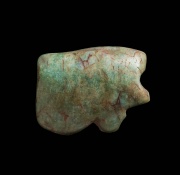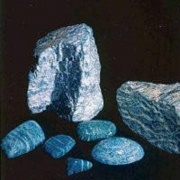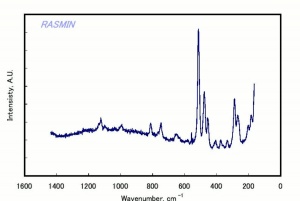Difference between revisions of "Amazonite"
Jump to navigation
Jump to search
| Line 1: | Line 1: | ||
[[File:72.1106-SC157850.jpg|thumb|Egyptian amulet<br>MFA Acc. #: 72.1106]] | [[File:72.1106-SC157850.jpg|thumb|Egyptian amulet<br>MFA Acc. #: 72.1106]] | ||
== Description == | == Description == | ||
| − | + | [[File:image 5-amazon stone.jpg|thumb|Amazon stone]] | |
A pale green, opaque [[microcline|microcline]] mineral. Amazonite derives its color from traces of lead and crystalline water (Aston et al 2000). Also called Amazon stone, it was used since about 3000 BCE for decorations, amulets, vessels, beads, and as a gemstone. Ancient examples have been found in Egypt, Mesopotamia, and northern India. Amazonite was considered one of the six most precious stones in Pharaonic Egypt. It is currently quarried in Russia and the U.S.(Colorado, Pennsylvania, Virgina). | A pale green, opaque [[microcline|microcline]] mineral. Amazonite derives its color from traces of lead and crystalline water (Aston et al 2000). Also called Amazon stone, it was used since about 3000 BCE for decorations, amulets, vessels, beads, and as a gemstone. Ancient examples have been found in Egypt, Mesopotamia, and northern India. Amazonite was considered one of the six most precious stones in Pharaonic Egypt. It is currently quarried in Russia and the U.S.(Colorado, Pennsylvania, Virgina). | ||
| Line 8: | Line 8: | ||
Amazon stone; amazonstone; mother of emerald; green feldspar; microcline; Amazonit (Deut.); amazonite (Fr., Port.); amazonita (Esp.); amazoniet (Ned.) | Amazon stone; amazonstone; mother of emerald; green feldspar; microcline; Amazonit (Deut.); amazonite (Fr., Port.); amazonita (Esp.); amazoniet (Ned.) | ||
| − | |||
[[[SliderGallery rightalign|amazoniteRS.jpg~Raman]]] | [[[SliderGallery rightalign|amazoniteRS.jpg~Raman]]] | ||
== Comparisons == | == Comparisons == | ||
Revision as of 11:23, 26 April 2022
Description
A pale green, opaque Microcline mineral. Amazonite derives its color from traces of lead and crystalline water (Aston et al 2000). Also called Amazon stone, it was used since about 3000 BCE for decorations, amulets, vessels, beads, and as a gemstone. Ancient examples have been found in Egypt, Mesopotamia, and northern India. Amazonite was considered one of the six most precious stones in Pharaonic Egypt. It is currently quarried in Russia and the U.S.(Colorado, Pennsylvania, Virgina).
Synonyms and Related Terms
Amazon stone; amazonstone; mother of emerald; green feldspar; microcline; Amazonit (Deut.); amazonite (Fr., Port.); amazonita (Esp.); amazoniet (Ned.)
Comparisons
Resources and Citations
- B.Aston, J.Harrell, I.Shaw, "Stone" in Ancient Egyptian Materials and Technology, P.Nicholson, I.Shaw (eds.), Cambridge University Press, 2000, p. 45-46.
- Mineralogy Database: Microcline
- G.S.Brady, Materials Handbook, McGraw-Hill Book Co., New York, 1971 Comment: p. 316
- Jack Odgen, Jewellery of the Ancient World, Rizzoli International Publications Inc., New York City, 1982
- Random House, Webster's Encyclopedic Unabridged Dictionary of the English Language, Grammercy Book, New York, 1997
- Frank A. Lent, Trade names and Descriptions of Marbles, Limestones, Sandstones, Granites and Other Building Stones Quarried in the United States Canada and other Countries., Stone Publishing Co, New York, 1925
- The American Heritage Dictionary or Encarta, via Microsoft Bookshelf 98, Microsoft Corp., 1998
- C.W.Chesterman, K.E.Lowe, Audubon Society Field Guide to North American Rocks and Minerals, Alfred A. Knopf, New York, 1979
- Thomas Gregory, The Condensed Chemical Dictionary, Reinhold Publishing, New York, 3rd ed., 1942
- George Savage, Art and Antique Restorer's Handbook, Rockliff Publishing Corp, London, 1954


